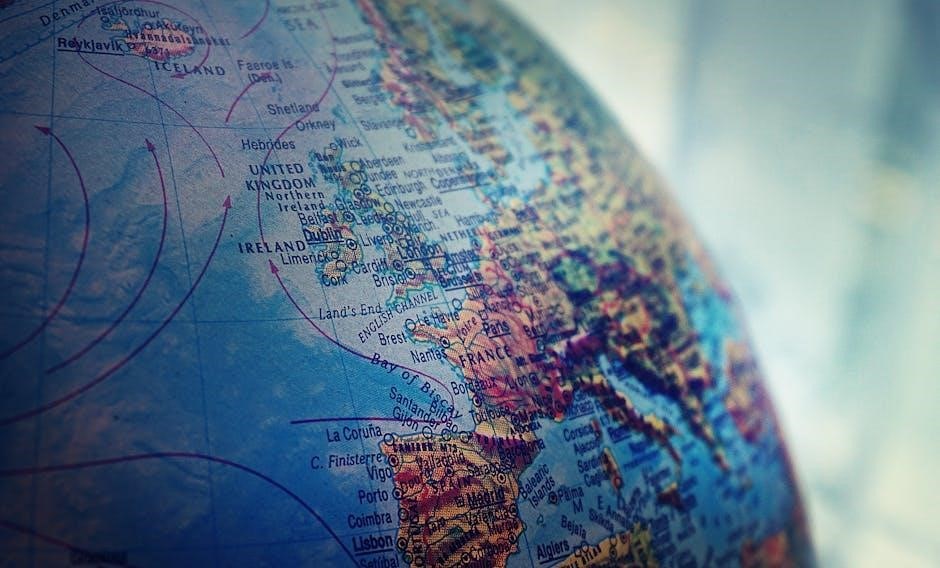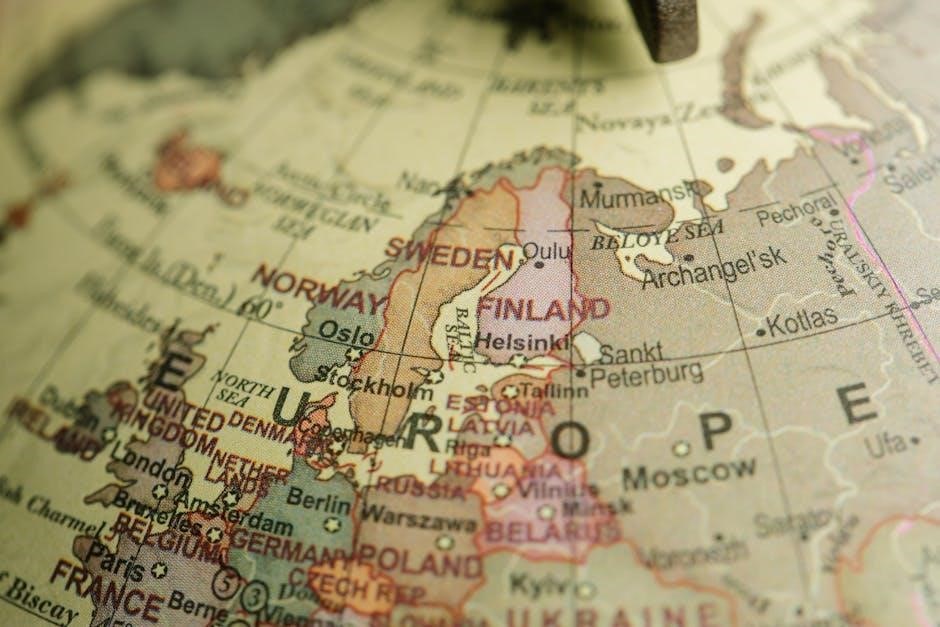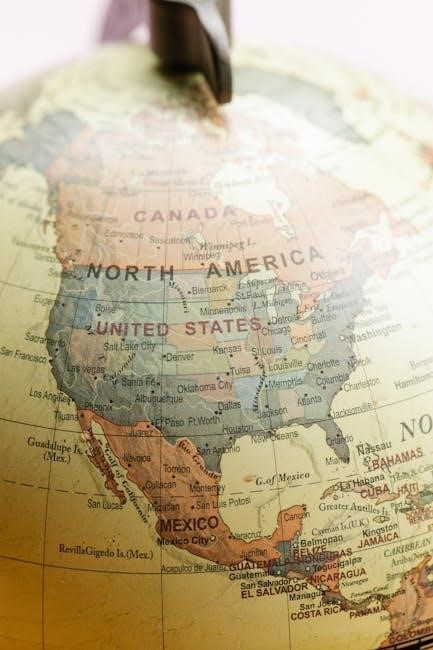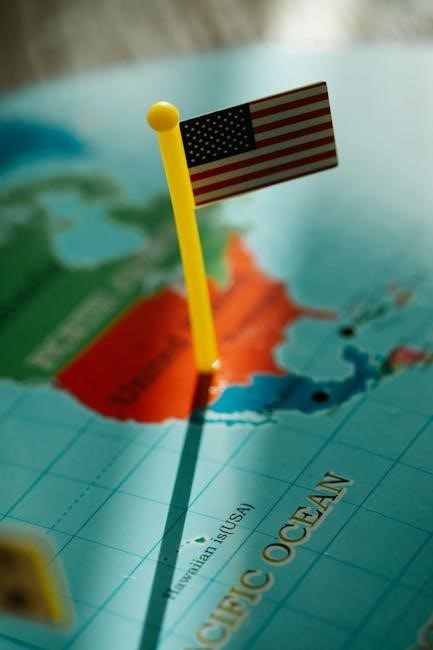World War I, one of history’s deadliest conflicts, occurred from 1914 to 1918, involving major global powers. It was sparked by Archduke Franz Ferdinand’s assassination, fueled by nationalism, alliances, imperialism, and militarism; The war reshaped global politics, economies, and societies, leaving a lasting legacy.
1.1. Overview of World War I
World War I (1914–1918) was a global conflict involving major powers like Britain, France, Germany, Austria-Hungary, and Russia. It was fueled by militarism, alliances, imperialism, and nationalism. The assassination of Archduke Franz Ferdinand in 1914 triggered the war, which escalated into a broader conflict. The war saw the introduction of new weapons and tactics, such as trench warfare, tanks, and aerial combat. It resulted in massive casualties, economic disruption, and societal changes. The Treaty of Versailles ended the war, imposing harsh penalties on Germany, which later contributed to World War II. The war’s legacy includes the rise of the United States and Russia as global powers and the redrawing of national borders.
1.2. Key Dates and Timeline
The assassination of Archduke Franz Ferdinand on June 28, 1914, triggered the start of World War I. Austria-Hungary declared war on Serbia on July 28, 1914, escalating the conflict. By August 1914, major powers like Germany, France, and Britain had joined the war. The United States entered the conflict in April 1917, while Russia withdrew in 1917 following the Russian Revolution. Key battles, such as the Battle of the Somme and Verdun in 1916, marked significant turning points. The war ended with the Armistice on November 11, 1918, and the Treaty of Versailles was signed in June 1919, officially ending the conflict.

Causes of World War I
Militarism, alliances, imperialism, and nationalism created a volatile environment in Europe, leading to the outbreak of World War I. These factors intensified tensions and competition among nations.
2.1. Militarism and the Arms Race
Militarism played a significant role in the lead-up to World War I, as nations prioritized military buildup and glorified warfare. The arms race intensified tensions, particularly between European powers like Britain, Germany, France, and Russia. Germany’s rapid naval expansion challenged Britain’s dominance, while France and Russia increased their military forces. This competition created an atmosphere of distrust and heightened readiness for conflict. Nations believed a strong military was essential for national security and prestige, leading to excessive weapon stockpiling. The emphasis on military preparedness made war seem inevitable, as countries were primed to respond aggressively to any threat. This mindset contributed directly to the outbreak of World War I.
2.2. Alliances and the Complex System
The complex system of alliances before World War I deeply influenced its outbreak. The Triple Alliance, consisting of Germany, Austria-Hungary, and Italy, opposed the Triple Entente of Britain, France, and Russia. These alliances created a volatile environment where a localized conflict could quickly escalate into a broader war. When Austria-Hungary declared war on Serbia, Russia mobilized to support Serbia, prompting Germany to declare war on Russia and France. Britain then entered the conflict to defend Belgium against German invasion. This chain reaction, driven by mutual defense agreements, transformed a regional dispute into a global conflict. The alliance system ensured that even a minor incident could spark widespread warfare, as nations felt compelled to honor their commitments. This rigid framework left little room for diplomacy, accelerating the rush to war.
2.3. Imperialism and Colonial Rivalries
Imperialism and colonial rivalries significantly contributed to the tensions leading to World War I. European powers competed for colonies, resources, and influence globally, particularly in Africa and Asia. This competition fostered economic rivalries and territorial disputes, exacerbating tensions between nations. The scramble for colonies not only strained relationships but also led to a race for resources and markets, which further fueled militarism and nationalism. The complex system of alliances was, in part, a response to these imperialist ambitions, as nations sought to secure their interests abroad. Imperialism created an atmosphere of competition and distrust, making war more likely as nations sought to protect and expand their empires. This rivalry played a crucial role in the outbreak of the conflict, as colonial ambitions intersected with the complex web of alliances.
2.4. Nationalism and Ethnic Tensions
Nationalism played a pivotal role in the lead-up to World War I, as ethnic tensions simmered across Europe. The rise of nationalist sentiment fueled demands for independence among various ethnic groups, particularly in the Balkans. Multi-ethnic empires like Austria-Hungary struggled to maintain unity amid growing separatist movements. Nationalist ideologies emphasized the superiority of one’s nation over others, fostering animosity and competition. These tensions were exacerbated by the complex system of alliances, as nations sought to protect their interests and ethnic kin. The assassination of Archduke Franz Ferdinand, carried out by a Serbian nationalist, ignited these simmering tensions, leading to the outbreak of war. Nationalism and ethnic rivalries thus contributed significantly to the conflict’s origins and escalation.
Key Events of World War I
Pivotal moments of World War I include the assassination of Archduke Franz Ferdinand, the United States’ entry in 1917, major battles like the Somme and Verdun, and the Armistice leading to the Treaty of Versailles.
3.1. The Assassination of Archduke Franz Ferdinand
The assassination of Archduke Franz Ferdinand on June 28, 1914, in Sarajevo, Bosnia, was the immediate trigger for World War I. Gavrilo Princip, a Serbian nationalist and member of the Black Hand group, carried out the killing. The Archduke’s visit to Sarajevo was intended to strengthen Austria-Hungary’s ties to Bosnia. Princip stepped forward and fired two shots from a pistol, killing both Franz Ferdinand and his wife, Sophie. This act of violence set off a chain reaction, as Austria-Hungary issued an ultimatum to Serbia, leading to declarations of war across Europe. The event symbolized the volatile mix of nationalism and political tensions that plunged the world into conflict.
3.2. The Outbreak of War and Initial Battles
Following Archduke Franz Ferdinand’s assassination, Austria-Hungary declared war on Serbia on July 28, 1914. This act triggered a chain reaction among European powers, as alliances were invoked. Germany, allied with Austria-Hungary, declared war on Russia and France, while Britain entered the conflict after Germany invaded neutral Belgium. The initial battles were marked by rapid mobilization and the execution of pre-war strategies, such as Germany’s Schlieffen Plan. The First Battle of the Marne in September 1914 halted Germany’s advance on Paris, while the Battle of Tannenberg saw Germany defeat Russia. These early clashes set the stage for the prolonged and brutal conflict that would follow.
3.3. Major Battles: The Somme, Verdun, and Others
The Battle of the Somme (1916) and Verdun (1916) were pivotal and devastating conflicts in World War I. The Somme, lasting from July to November 1916, saw the first use of tanks and resulted in over one million casualties. Verdun, fought between French and German forces from February to December 1916, was a brutal test of endurance, causing massive losses on both sides. Other significant battles included Passchendaele (1917), marked by heavy artillery and atrocious conditions, and Cambrai (1917), where tanks played a decisive role. These battles showcased the horrors of trench warfare and the futility of frontal assaults, leading to massive human tolls and a reevaluation of military tactics.
3.4. The United States’ Entry into the War
The United States initially maintained neutrality in World War I, focusing on economic interests and avoiding direct involvement. However, Germany’s resumption of unrestricted submarine warfare and the sinking of the passenger ship Lusitania in 1915 shifted public opinion. The final catalyst was the Zimmermann Telegram (1917), where Germany attempted to ally with Mexico against the U.S. This, combined with economic ties to the Allies and growing anti-German sentiment, led to the U.S. declaring war on Germany in April 1917. American entry brought fresh resources and troops, significantly impacting the war’s outcome and establishing the U.S. as a global power.
3.5. The Russian Withdrawal and Revolution
Russia’s involvement in World War I was marked by heavy losses and internal turmoil. The country faced economic collapse, food shortages, and military defeats, leading to widespread discontent. In 1917, the February Revolution forced Tsar Nicholas II to abdicate, and a provisional government took power. However, continued war efforts and political instability led to the October Revolution, where the Bolsheviks, led by Vladimir Lenin, seized control. Russia withdrew from the war with the Treaty of Brest-Litovsk in 1918, focusing on internal consolidation. This marked the end of Russia’s involvement in World War I and the birth of the Soviet Union, reshaping global politics.
The Home Front During World War I
During World War I, the home front saw significant changes. Economies mobilized for war production, women entered the workforce, and propaganda shaped public opinion, with rationing and shortages impacting daily life.
4.1. Mobilization of Resources and Economies
During World War I, governments mobilized resources on an unprecedented scale to support the war effort. Economies shifted from producing consumer goods to manufacturing weapons, ammunition, and military equipment. Industrial production was prioritized, with factories repurposed to meet wartime demands. Rationing systems were implemented to manage scarce resources, ensuring supplies for both soldiers and civilians. The mobilization of resources also led to significant societal changes, as women entered the workforce in large numbers to replace men who had enlisted. This period saw the rise of government control over economies, with centralized planning and coordination becoming essential to sustain the war effort and maintain societal stability.
4.2. The Role of Women in the War Effort
The role of women during World War I expanded significantly as they stepped into new responsibilities previously held by men. With millions of soldiers deployed, women entered the workforce in unprecedented numbers, working in factories, farms, and transport. They also served in military support roles, such as nursing and administrative positions. This shift challenged traditional gender norms and demonstrated women’s capabilities in diverse fields. The establishment of organizations like the Women’s Land Army highlighted their contributions to agriculture. Women’s involvement in the war effort not only supported the military but also laid the groundwork for future gender equality movements, proving their essential role in society beyond domestic duties.
4.3. Propaganda and Public Opinion
Propaganda played a crucial role in shaping public opinion during World War I. Governments used posters, films, and media to promote patriotism, encourage enlistment, and demonize the enemy. Messages often emphasized the justness of their nation’s cause and the necessity of sacrifice. Propaganda aimed to unite citizens behind the war effort, fostering a sense of national duty. It also served to counter anti-war sentiments and maintain morale. Governments tightly controlled information, censoring news to project optimism and hide the harsh realities of the conflict. This manipulation of public perception helped sustain support for the war, even as its devastating impact became apparent. Propaganda’s influence extended beyond the battlefield, leaving a lasting imprint on societal attitudes.
4.4. Economic and Social Changes
World War I triggered significant economic and social transformations globally. Wartime economies shifted to prioritize military production, leading to shortages of consumer goods and inflation. Governments implemented rationing systems and controls over industries to manage resources. Labor shortages prompted the recruitment of women into the workforce, especially in industries and roles traditionally held by men. This shift challenged gender norms and laid the groundwork for future social change. The war also disrupted global trade, causing supply chain issues and economic instability. Socially, the conflict deepened class divisions, as the burden of war fell heavily on the working class. These changes reshaped societies, leaving a lasting legacy in economic structures and social dynamics.

Technological Advancements and Warfare
World War I introduced revolutionary weapons and tactics, transforming modern warfare. New technologies like tanks, poison gas, and machine guns increased lethality and changed battlefield strategies significantly.
World War I saw the introduction of revolutionary weapons and tactics that transformed warfare. Machine guns, poison gas, and tanks debuted, causing unprecedented destruction. Trench warfare became dominant, with barbed wire and artillery intensifying battlefield lethality. Airplanes emerged for reconnaissance and combat, while submarines disrupted naval supply lines. These innovations shifted warfare from traditional methods to industrialized conflict, leading to massive casualties and prolonged stalemates. The development of new weaponry and strategies not only changed the dynamics of World War I but also set the stage for modern military tactics, leaving a lasting impact on global conflict strategies.
5;2. Trench Warfare and Its Impact
Trench warfare became a defining feature of World War I, as soldiers on both sides dug extensive networks of trenches for protection. These trenches were often cramped, unsanitary, and prone to flooding, leading to the spread of diseases like trench foot. The use of barbed wire and machine guns made crossing no man’s land nearly impossible, resulting in stalemates and massive casualties. Trench warfare also took a mental toll, with soldiers experiencing prolonged exposure to constant artillery fire and the ever-present threat of death. This form of warfare highlighted the brutal efficiency of modern weaponry and the need for new strategies, while also deeply affecting the soldiers who endured it.
5.3. The Emergence of Tank and Aerial Warfare
The introduction of tanks in World War I revolutionized land warfare, breaking the stalemate of trench warfare. First deployed by Britain in 1916, tanks provided mobile protection against machine guns and enabled ground advances. Though initially slow and unreliable, they marked a significant shift in military tactics. Aerial warfare also emerged as a key component, evolving from reconnaissance to combat. Planes were initially used for scouting but soon adapted for dogfighting and bombing, introducing air superiority as a strategic factor. These innovations underscored the rapid technological advancements driven by the war, setting the stage for modern mechanized and air-based military strategies. Their impact on future warfare was profound, reshaping battlefield dynamics forever.

The End of World War I
World War I concluded with the Armistice on November 11, 1918, followed by the Treaty of Versailles in 1919. The treaty imposed harsh reparations on Germany, reshaped global borders, and left economic and political turmoil in its wake.
6.1. The Armistice and Treaty of Versailles
World War I officially ended with the Armistice on November 11, 1918, followed by the Treaty of Versailles in June 1919. The treaty, signed by the Allied Powers and Germany, imposed harsh reparations, territorial losses, and strict limitations on Germany’s military. The War Guilt Clause blamed Germany for the war, fueling widespread resentment. The treaty also redrew national borders, leading to the dissolution of empires and the creation of new states. While it aimed to establish a lasting peace, the treaty’s punitive measures contributed to economic hardship in Germany and sowed seeds of discontent that would later contribute to World War II.
6.2. The Human Cost and Casualties
World War I resulted in unprecedented human suffering, with millions of soldiers and civilians killed or wounded. Over 37 million people were casualties, including 17 million deaths, making it one of the deadliest conflicts in history. Soldiers faced horrendous conditions in trenches, leading to massive losses from battles, diseases, and new weaponry like machine guns and poison gas. Civilians also suffered greatly due to food shortages, bombings, and the Spanish Flu pandemic. The war left families devastated, communities shattered, and societies emotionally scarred, with long-lasting psychological and social impacts on those who survived. The immense human toll remains a stark reminder of the war’s horrors.

The Aftermath and Legacy of World War I
World War I ended with the Treaty of Versailles, redrawing global borders and birthing new nations. Economic devastation, reparations, and inflation plagued Europe, while fascism and communism rose, reshaping the world.
7.1. The Rise of New Nations and Borders
The aftermath of World War I led to significant territorial changes, with the dissolution of empires and the emergence of new nations. The Treaty of Versailles redrew borders, creating states like Poland and Czechoslovakia. The Ottoman Empire’s collapse allowed for the establishment of modern Middle Eastern nations under the Mandate System. Meanwhile, the Austro-Hungarian Empire fragmented into smaller countries. These changes aimed to reflect ethnic and national self-determination but often resulted in unresolved tensions. The redrawing of borders also sowed seeds for future conflicts, as many nations felt their territorial ambitions unfulfilled or their populations divided. This reshaping of the global map remains a critical legacy of the war.
7.2. The Impact on Global Politics and Society
World War I profoundly reshaped global politics and society, fostering widespread economic hardship and social change. The war disrupted trade, causing inflation and unemployment, while governments accumulated massive debts. Societies experienced shifts in gender roles, as women entered the workforce in unprecedented numbers. Propaganda became a tool for shaping public opinion, influencing perceptions of the war. The conflict also accelerated the decline of colonial empires and the rise of the United States as a global power. Additionally, the war’s aftermath saw the emergence of authoritarian regimes and revolutionary movements, such as Bolshevism in Russia. These changes laid the groundwork for future political and social transformations worldwide.
7.3. The Legacy of the War in Modern History
World War I left a profound and lasting impact on modern history, shaping global dynamics for decades. The war’s aftermath seeded the roots of World War II, as the Treaty of Versailles imposed harsh penalties on Germany, fostering resentment. It also led to the rise of authoritarian regimes, including Nazi Germany and Fascist Italy, while accelerating the decline of European empires. The war’s economic toll disrupted global trade and spurred inflation, influencing post-war monetary policies. Culturally, it inspired movements in art, literature, and philosophy, reflecting the trauma and disillusionment of the era. The war’s legacy remains evident in modern international relations, military strategies, and societal values, underscoring its enduring influence.

